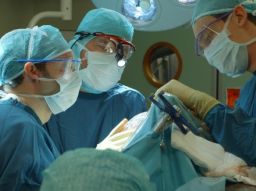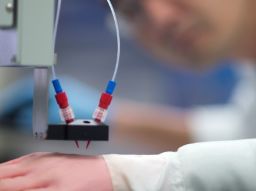Vital Signs is a monthly program bringing viewers health stories from around the world.
Story highlights
Researchers 3-D printing growing range of body parts
Creations range from plastic prostheses to parts made from living cells
Much work is at the research stage, but could soon be used in humans
The 21st century has seen the growth of 3-D printing, with well-known applications in architecture, manufacturing, engineering, and now increasingly in medicine.
The birth of 3-D scanning technologies combined with organic inks and thermoplastics has enabled the “bioprinting” of a range of human body parts to accommodate a wide range of medical conditions. Let’s start form the top.
Skulls
Doctors at University Medical Center Utrecht, in Holland, have reported successfully performing the first surgery to completely replace a patient’s skull with a tailor-made plastic version that was 3-D printed.
The patient had a chronic bone disorder that caused her skull to be 5cm thick. The hospital said the condition had caused her to lose her vision and ultimately would have killed her, but that three months after the operation the patient regained her vision and was able to return to work.

Eyes
Batch-printing of up to 150 prosthetic eyes an hour has become a reality according to UK-based company Fripp Design and Research. The mass-production technique promises to speed up the manufacture of eye prostheses and drive down the cost. Printing each eye with slight variation in color is intended to produce better aesthetic results.
The aim is to ensure more affordable eyes for the developing world with countries such as India reportedly showing interest in the products. The company, in collaboration with the UK’s Manchester Metropolitan University, hopes to implement the use of its printed eyes within the next year.
Noses and Ears
Fripp Design has also collaborated with the University of Sheffield, in the United Kingdom, to produce facial prostheses such as ears and noses. 3-D facial scans of patients are used to print out prosthetics using pigments, starch powder and silicone for replica facial parts closely matching the patient’s original nose or ear. The real benefit here is that once parts begin to wear, they can be re-ordered at a fraction of the cost as the technology and design will already be in place. The simpler process of scanning a patient’s face, rather than more invasive face molds needed for traditional prostheses, also makes the process a lot more patient-friendly.
A team at Cornell University, in the United States, is doing things differently. It’s printing 3-D molds of a patient’s ear using ink gels containing living cells. The printed products are injected with bovine cartilage cells and rat collagen and incubated until they are ready three months later. Human transplants could be possible within three years, say researchers.
Read: Carpenter cuts off fingers, prints new ones
Synthetic Skin
James Yoo at the Wake Forest School of Medicine in the United States is developing a printer that will print skin straight onto the wounds of burn victims. The “ink” they’re using consists of enzymes and collagen which once printed are layered with tissue cells and skin cells which combine to form the skin graft. The team plans on developing portable machines to print skin directly onto wounds in remote and war-torn settings.
The ideal synthetic skin graft needs to match the coloration of the patient as accurately as possible in order for the graft to look natural. Dr. Sophie Wuerger and her team at the University of Liverpool in the UK are working on using 3-D cameras, image processing and skin modeling to ensure the tone and texture of printed skin match up to the real thing.

Limbs
Thermoplastics have led the way in the growth of printable hands, arms and even individual fingers. Richard Van As is one of those producing affordable hand and finger prostheses with his company Robohand, based in South Africa. The team is creating functional fingers for use on amputated hands by combining the printing of the thermoplastic polylactide with aluminum and stainless steel digits to create a functioning mechanical finger.
Robohand recently collaborated with U.S. entrepreneur Mike Ebeling on a project providing affordable printed arms to war amputees in Sudan. The collaboration is known as “Project Daniel,” named after 14 year-old Daniel Omar who lost both his hands and part of his arms after a bomb was dropped near his family home in Sudan’s Nuba mountains. The team is enabling Robohands to reach the masses at costs as small as $100 for a basic hand.
Bones
One of the more established fields of 3-D printing is the bioprinting of human bone implants, and now replacement bones.
In 2011, researchers at Washington State University announced they had printed a bone-like structure that acts as a scaffold for new bone cells to grow on, before it degrades. The structure was printed using calcium phosphate and has been successfully tested in animals. The hope is to print customized grafts for use in patients with bone fractures.
Read: 3-D printed arm gives hope to boy maimed by bomb














